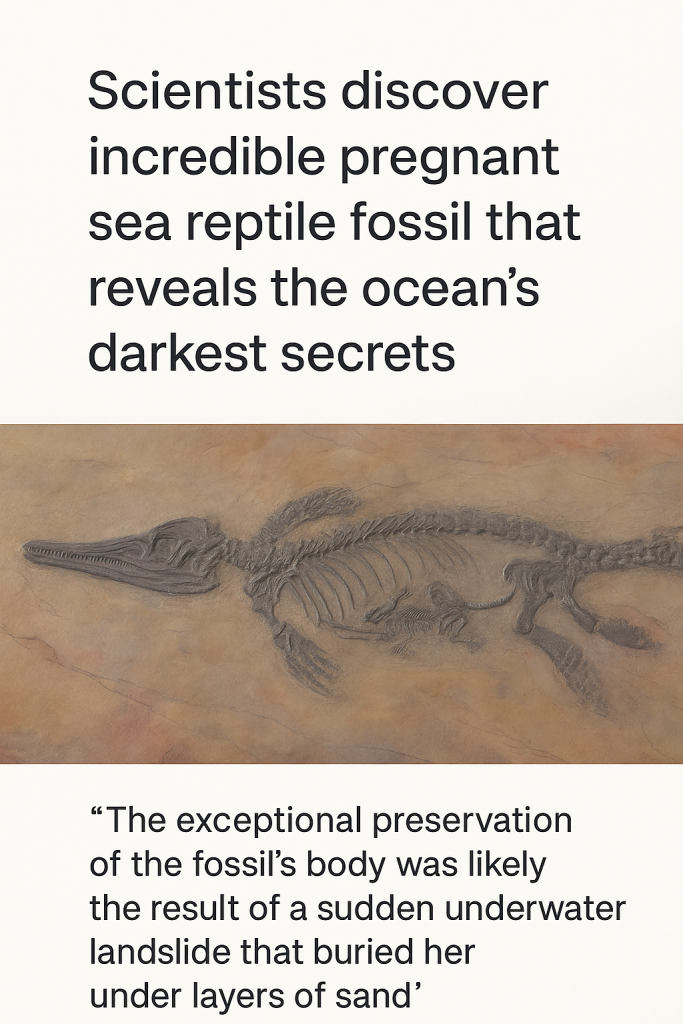In a groundbreaking discovery that is captivating the scientific world, researchers have uncovered an exceptionally well-preserved fossil of a pregnant sea reptile, shedding new light on the mysterious ecosystems of prehistoric oceans and opening a window into some of their darkest secrets.
The fossil, dated to approximately 140 million years ago during the Cretaceous period, belongs to a marine reptile species closely related to the ichthyosaurs—a group of dolphin-like reptiles that thrived in ancient seas. What makes this finding truly extraordinary is the fossilized embryo inside the mother’s body, captured in remarkable detail thanks to the fossil’s exceptional preservation.
This discovery is being hailed as one of the most significant paleontological finds of the decade because it provides compelling direct evidence about reproductive biology in these ancient creatures. For the first time, scientists can observe the developmental stage of the embryo and gain insights into the gestation and birthing processes of marine reptiles that dominated prehistoric oceans.
According to the research team, who studied the fossil using advanced imaging techniques like high-resolution CT scans, the pregnant sea reptile reveals several fascinating secrets about ancient marine life. The embryo’s position inside the fossil suggests viviparity—giving birth to live young—instead of laying eggs on land, a key evolutionary adaptation that allowed these reptiles to fully inhabit oceanic environments.
The preservation of soft tissues and delicate bone structures is virtually unprecedented, making this fossil a rare window into the biology of these elusive creatures. Scientists say that such preservation can only occur under very specific conditions, likely involving rapid burial in fine sediment and low oxygen levels that prevented decay and scavenging. As a result, features like the mother’s skin outline and the embryo’s developing skeleton are still visible.
Beyond reproductive habits, the fossil is revealing information about ancient ocean ecosystems. Isotopic analysis conducted on the fossilized remains indicates water temperatures and chemical composition of the sea where the reptile lived, contributing valuable data to our understanding of climate and marine conditions more than a hundred million years ago.
Marine reptiles like ichthyosaurs were apex predators, and this discovery supports theories about their life cycles, behavior, and how they adapted to shifting oceanic environments during the Cretaceous period—a time when the Earth’s climate was warmer and sea levels higher.
Experts believe this find will inspire a wave of further research into ancient marine life and evolutionary biology. The combination of fossilized reproductive evidence and environmental clues makes it a multidisciplinary treasure trove, combining paleontology, geology, and marine science.
As the study unfolds, this pregnant sea reptile fossil is destined to become a symbol of the ocean’s ancient mysteries, unveiling evolutionary secrets that have been buried for millions of years beneath the waves. It reminds us how much there still is to learn about the creatures that once inhabited our planet’s vast oceans—and how remarkable the preservation of their stories can be.
Scientists plan to continue detailed investigations on the fossil, hoping to discover more about the mother’s species, her diet, and the pressures faced by marine reptiles as they adapted to their environment. This extraordinary find is a compelling chapter in the ongoing story of life on Earth.



